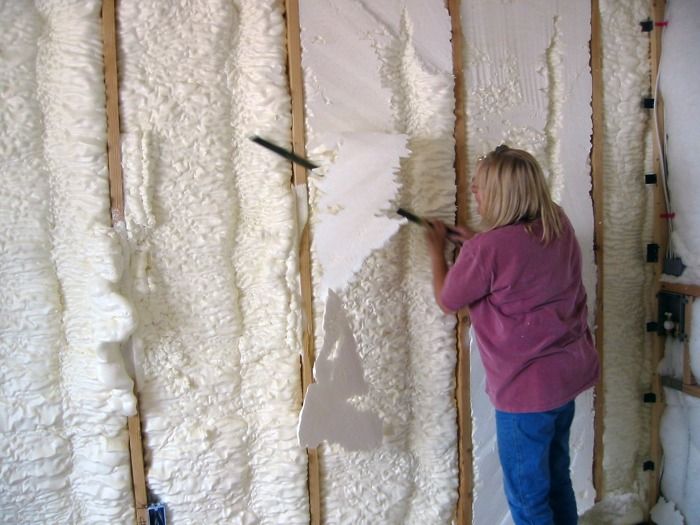
Builders who run the other way when someone suggests using fiberglass-batt insulation may want to rethink their point of view. A study released by an industry trade group says one type of wall insulation performs as well as any other as long as it is installed correctly and the wall has been air-sealed.
That conclusion comes from an updated Thermal Metric Summary Report compiled by the Building Science Corp. and released this week by the North American Insulation Manufacturers Association (NAIMA), a trade group representing manufacturers of fiberglass, rock-wool, and slag-wool insulation.
“R-value is R-value,” NAIMA said in reporting the latest results of the multi-year study. “When walls are constructed to the same R-value and properly sealed, all insulation types perform essentially the same.”
The findings aren’t new. A preliminary version of the report was released almost two years ago, NAIMA said, comparing fiberglass batts, cellulose, closed-cell spray foam and foam sheathing. But open-cell spray foam wasn’t included because of defects in a test wall. The updated version of the report, dated June 2015, also includes test results involving R-15 fiberglass batts and R-15 blown-in fiberglass insulation.
NAIMA said R-15 fiberglass batts performed better than a wall insulated to R-13 with open-cell spray foam and better than R-12 worth of closed-cell foam.
“The results of this research clearly demonstrate that there is no single ‘best’ insulation material and that all insulation materials perform equally well when properly air-sealed and installed, debunking the claims that spray-foam insulation performs better than other insulation types and provides air sealing for the whole building.”
Search continues for an R-value replacement
The industry-funded research is part of what’s turning out to be a very long process aimed at replacing R-value with another metric for describing thermal performance.
Joseph Lstiburek, a principal at Building Science Corp., (BSC) announced in 2007 it was time for the R-value to be retired and replaced with a metric that took into account more complexities of building assemblies and site conditions. As GBA’s Martin Holladay reported nearly four years ago, BSC built a new test platform, called a double-guarded hot box, with the aim of measuring heat and mass flows. But testing dragged on for years without any firm conclusion.
As the report notes, BSC joined with six companies in the industry–including NAIMA and Icynene, a manufacture of open-cell foam–to develop a replacement for R-value.
“The Thermal Metric Project was initiated in response to renewed focus on building-system performance and increasing use of a broader range of building materials and systems,” the report notes. “These factors highlight the shortcomings of the dominant thermal-performance metric, namely R-value. Contemporary insulation materials and systems are more or less sensitive to thermal bridging, workmanship (i.e. quality of installation), internal convection, and through convection (i.e. infiltration, exfiltration, wind washing, and re-entrant looping).
“The impact of such ‘anomalies’ and ‘defects’ are not captured in the standard (label and installed) R-value metric,” it said.
Researchers still have more work to do:
“At this stage of the research project, the industry partners have not proposed a new metric for quantifying the thermal performance of insulation beyond conventional R-value,” NAIMA said, “and the report does not include any recommendations for a new metric.”
But the study did yield a number of observations:
- All of the test walls are subject to thermal bridging, regardless of what type of insulation was used in the stud cavities. Thermal bridging through the framing lowered thermal performance by about 15%.
- Commercially available heat-transfer models do a good job of predicting thermal bridging, as did the ASHRAE Handbook of Fundamentals.
- All types of insulation show changes in thermal performance with changes in temperature. Lower mean temperatures mean higher R-values; higher temperatures make for lower R-values.
- No matter what type of insulation is used, all wall assemblies show some loss of thermal performance when air is permitted to move through them.
Read more: http://www.greenbuildingadvisor.com/blogs/dept/green-building-news%2A#ixzz3gk7M6ltd
Follow us: @gbadvisor on Twitter | GreenBuildingAdvisor on Facebook
Fine Homebuilding Recommended Products
Fine Homebuilding receives a commission for items purchased through links on this site, including Amazon Associates and other affiliate advertising programs.

8067 All-Weather Flashing Tape

Reliable Crimp Connectors

Handy Heat Gun

No better than batts? An updated study debunks the notion that spray-foam insulation is inherently better than fiberglass batt insulation, providing the insulation is installed correctly and the wall is air-sealed.


























